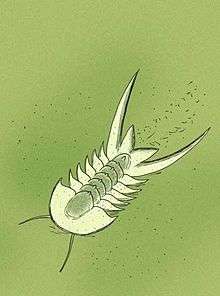Aaveqaspis
Aaveqaspis is a genus of small (about 2.5 centimetres or 1.0 inch long) marine arthropods of unclear affiliation, that lived during the early Cambrian period.[1] Fossil remains of Aaveqaspis were collected from the Lower Cambrian Sirius Passet fossil-Lagerstätte of North Greenland. Aaveqaspis looks like a soft eyeless trilobite with a weakly defined axis, a headshield (or cephalon) with stubby genal spines, 5 thorax segments also ending in stubby genal spines, and a tailshield (pygidium) with a pair of massive tusk-like spines, and two smaller spines near the end of the axis. The only species presently known is A. inesoni (i.e. the genus is monotypic).
| Aaveqaspis inesoni | |
|---|---|
 | |
| Scientific classification | |
| Kingdom: | |
| Phylum: | |
| Class: | |
| Genus: | Aaveqaspis Peel & Stein, 2009 |
| Species: | A. inesoni |
| Binomial name | |
| Aaveqaspis inesoni Peel & Stein 2009 | |
| Part of a series on |
| The Cambrian explosion |
|---|
 |
|
Fossil localities |
|
Evolutionary concepts |
Etymology
The name of the genus is a compound of the Greenlandic word aaveq (walrus), reflecting the likeness of the tail spines to the tusks of a walrus, and the Greek word aspis (shield). The species was named after Jon R. Ineson to honour him for his studies of the Cambrian of North Greenland.[1]
Description
Aaveqaspis inesoni is almost flat (dorso-ventrally). Its body is narrowly oval in general outline, disregarding the two large spines. The upper non-calcified (or dorsal) side of the body consists of a cephalon, 5 thorax segments, and a pygidium. The axis is slightly raised, but without a discernible furrow defining its outline. The axis is about 20% of the width of the cephalon. The cephalon is halfround, and almost twice as wide as long (along the axis). The (posterolateral) corners of the cephalon are acute, ending in short stout spines. The back margin of the cephalon from the spine to the midline has in the pleural region a forward angle and is first concave, then convex, then concave again, attaining a backward angle when reaching the axis, and finally convex, with a small node or median spine reaching the back margin. This pattern is repeated with all thorax segments. Antennae are not known. Dorsal eyes are absent. The thorax segments are each about 1.5 millimetres (0.06 in) along the axis. The tail shield is dominated by a pair of large segmental marginal spines, reminiscent of large (or macropleural) spines in the thorax and of pygidial spines of certain trilobites. The one node it carries is larger and more sharply defined than the nodes on the segments. The frontal border of the tail shield is convex and curves laterally into the large spines which extend postero-laterally, constituting half the total body length. The back margin of the spines is concave and merges into a second pair of short, broad, triangular spines. Body parts on the belly (or ventral) side are not known, including any appendages.[1]
Differences with recognized Liwiidae
Buenaspis forteyi and Liwia convexa are similar in general body form to A. inesoni.[1] B. forteyi is isopygous, with 6 thorax segments instead of the 5 of A. inesoni. B. forteyi also differs by having a lengthwise mid-ridge on cephalon and pygidium, and the pygidium lacks marginal spines. Liwia has 4 thorax segments. Although the pygidium of Liwia has five pairs of modest marginal spines, the 2 pairs of spines and one node in A. inesoni suggest its pygidium is a composite of only two segments.
Distribution
A. inesoni has been collected from the Lower Cambrian (Atdabanian) Buen Formation, Sirius Passet Fossil-Lagerstätte, Peary Land, North Greenland, 82°47′6″N 106°12′7″E, on the south side of the broad valley known as Sirius Passet at its junction with J. P. Koch Fjord.[1]
Habitat
Aaveqaspis inesoni was probably a marine bottom dweller, that lived in deeper water. This may be deduced from the dominance of eyeless forms and the absence of seaweeds at the collection site.[1]
Taxonomic position
The taxonomic position of A. inesoni is unclear.[1] Its likeness to Buenaspis and Liwia may suggest Aaveqaspis could be assigned to the order Nectaspida and family Liwiidae.
References
- John S. Peel & Martin Stein (2009). "A new arthropod from the Lower Cambrian Sirius Passet fossil-lagerstätten of North Greenland" (PDF). Bulletin of Geosciences. 84 (4): 625–630. doi:10.3140/bull.geosci.1158.
External links
